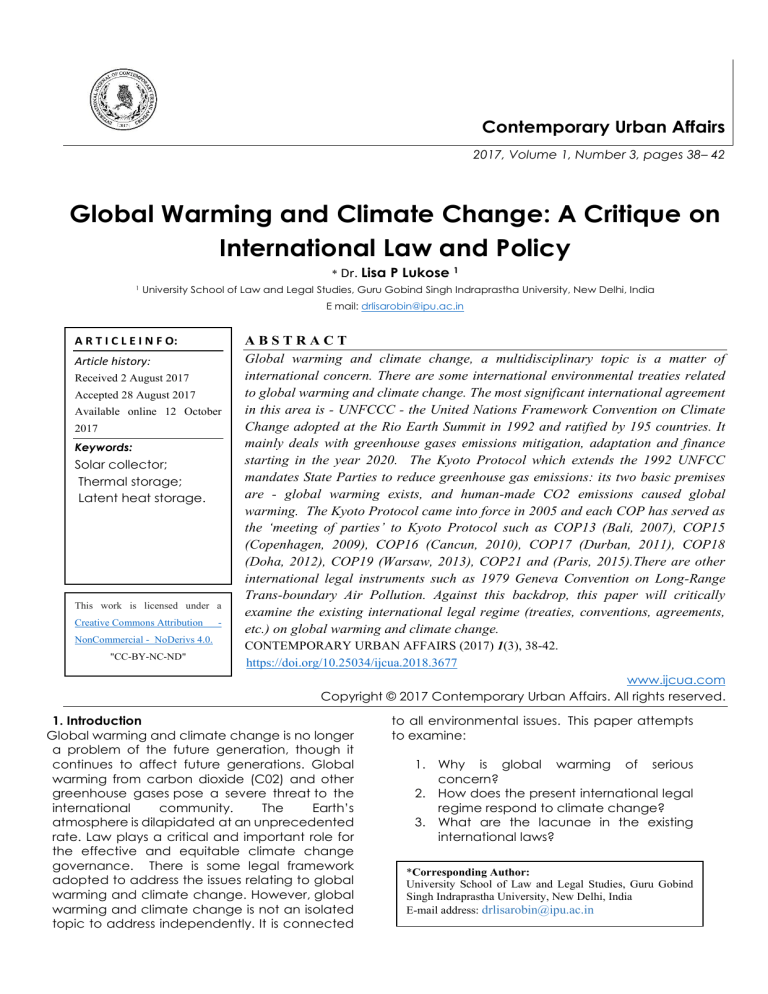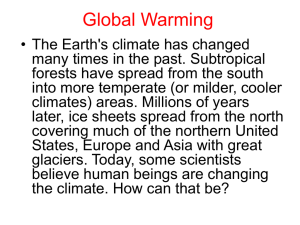
Contemporary Urban Affairs
2017, Volume 1, Number 3, pages 38– 42
Global Warming and Climate Change: A Critique on
International Law and Policy
* Dr. Lisa
1
P Lukose 1
University School of Law and Legal Studies, Guru Gobind Singh Indraprastha University, New Delhi, India
E mail: drlisarobin@ipu.ac.in
A R T I C L E I N F O:
Article history:
Received 2 August 2017
Accepted 28 August 2017
Available online 12 October
2017
Keywords:
Solar collector;
Thermal storage;
Latent heat storage.
This work is licensed under a
Creative Commons Attribution
NonCommercial - NoDerivs 4.0.
"CC-BY-NC-ND"
-
ABSTRACT
Global warming and climate change, a multidisciplinary topic is a matter of
international concern. There are some international environmental treaties related
to global warming and climate change. The most significant international agreement
in this area is - UNFCCC - the United Nations Framework Convention on Climate
Change adopted at the Rio Earth Summit in 1992 and ratified by 195 countries. It
mainly deals with greenhouse gases emissions mitigation, adaptation and finance
starting in the year 2020. The Kyoto Protocol which extends the 1992 UNFCC
mandates State Parties to reduce greenhouse gas emissions: its two basic premises
are - global warming exists, and human-made CO2 emissions caused global
warming. The Kyoto Protocol came into force in 2005 and each COP has served as
the ‘meeting of parties’ to Kyoto Protocol such as COP13 (Bali, 2007), COP15
(Copenhagen, 2009), COP16 (Cancun, 2010), COP17 (Durban, 2011), COP18
(Doha, 2012), COP19 (Warsaw, 2013), COP21 and (Paris, 2015).There are other
international legal instruments such as 1979 Geneva Convention on Long-Range
Trans-boundary Air Pollution. Against this backdrop, this paper will critically
examine the existing international legal regime (treaties, conventions, agreements,
etc.) on global warming and climate change.
CONTEMPORARY URBAN AFFAIRS (2017) 1(3), 38-42.
https://doi.org/10.25034/ijcua.2018.3677
www.ijcua.com
Copyright © 2017 Contemporary Urban Affairs. All rights reserved.
1. Introduction
Global warming and climate change is no longer
a problem of the future generation, though it
continues to affect future generations. Global
warming from carbon dioxide (C02) and other
greenhouse gases pose a severe threat to the
international
community.
The
Earth’s
atmosphere is dilapidated at an unprecedented
rate. Law plays a critical and important role for
the effective and equitable climate change
governance. There is some legal framework
adopted to address the issues relating to global
warming and climate change. However, global
warming and climate change is not an isolated
topic to address independently. It is connected
to all environmental issues. This paper attempts
to examine:
1. Why is global warming of serious
concern?
2. How does the present international legal
regime respond to climate change?
3. What are the lacunae in the existing
international laws?
*Corresponding Author:
University School of Law and Legal Studies, Guru Gobind
Singh Indraprastha University, New Delhi, India
E-mail address: drlisarobin@ipu.ac.in
JOURNAL OF CONTEMPORARY URBAN AFFAIRS, 1(3), 38-42 / 2017
4. How can climate law respond better to
the diverse contemporary requirements?
5.
2. Method and Material
The author has adopted a doctrinal and
analytical method to develop this paper. The
material is drawn from both primary and
secondary sources. The primary sources are the
legal instruments while secondary sources are
offline and online resource materials which are
cited in this paper at relevant places.
3. Effect of Global Warming
The immediate effect of global warming is
climate change. The impact of global warming
is in fact much beyond climate change. It
adversely affects human development, and it
does have a long-term impact on the
environment. Temperature increase, extreme
weather events, flood, drought, sea level rise,
erratic precipitation, melting glaciers, reduced
snow cover are few impacts to mention. Its
impact on aquaculture, biological diversity,
agriculture, health, and livelihood is dangerous.
It also adversely affects a broad range of other
human rights (Workshop in the Context of the
UNFCCC COP 20 , 2014), for example, right to
food, indigenous peoples right, etc.
A large section of the world population is
suffering from the effects of climate change. In
2009 it was estimated that about 300000 people
die annually due to the adverse effect of climate
change and 325 million are further seriously
affected (Annan, 2009). Since developing
countries have less financial and technological
resources, they are more vulnerable to the
impacts of climate change.
4. UNFCCC 1992
The United Nations Framework Convention on
Climate Change (one among the three
adopted at the Rio Earth Summit-1992)1 is
described as “first steps to a safer future” which
was a global response to climate change.
Because the global community for the first time
recognized and accepted that the climate
change is a ‘problem’ despite having less
scientific evidence than now. It is adopted on 9
May 1992 and came into force on 21 March
1994. It is one of the most widely accepted
treaties having a near-universal membership. It
1
The other two sister Rio Earth Summit
Conventions are (i) the UN Convention on
Biological Diversity and (ii) the Convention to
neither has any binding limit on the emission of
green gas for member countries nor has
enforcement mechanisms.
The basic aim of UNFCCC is to prevent
dangerous human interference with the
climate system. By borrowing from the Montreal
Protocol 1987, it bounds member states to “act
in the interests of human safety even in the face
of scientific uncertainty.” UNFCCC is an
international framework
seeking global
cooperation to combat climate change by
limiting average global temperature increases
and the resulting climate change and coping
with impacts that were, by then, inevitable. It
obliges the members to stabilize greenhouse
gas concentrations at a level that would
prevent
dangerous
anthropogenic
interference with the climate system. It states
how
specific
international
treaties/protocols/Agreements
may
be
negotiated to accomplish UNFCCC objectives.
5. UNFCC to KYOTO
By the agreements adopted in Copenhagen
(2009) and Cancun (2010) countries promised to
set a goal of maintaining temperature increases
below 2 degrees Celsius above pre-industrial
levels. It also explored financial options for
implementation of REDD-plus actions. The
developed countries committed to mobilizing
$100 billion a year in public and private finance
for developing countries by 2020. COP 17 at
Durban
(2011)
recognized
that
“smart
government policy, smart business investment,
and the demands of an informed citizenry, all
motivated by an understanding of mutual selfinterest, must go hand in hand in pursuit of the
common goal.”
COP 18 Doha (2012) resulted in an amendment
to the Kyoto Protocol establishing a second
commitment period from 2013–20. It also added
more item to list of greenhouse gases. At COP 19
in Warsaw (2013) the governments were
encouraged to submit their intended nationally
determined contributions (INDCs) to the Paris
Agreement. INDCs represent member country’s
self-defined mitigation goals from 2020. 190
countries accounting for 99 percent of global
emissions have already submitted INDCs to the
UNFCCC. At COP 20 in Lima (2014) more than
Combat Desertification. All the three conventions
aim to encourage mutual cooperation for developing
synergies in their activities. Now it incorporates
Ramsar Convention on Wetlands as well.
Lisa P Lukose
39
JOURNAL OF CONTEMPORARY URBAN AFFAIRS, 1(3), 38-42 / 2017
190 countries pledged to develop new” urgency
towards fast-tracking adaptation and building
resilience across the developing world” (Lima
Call for Action).
6. The Kyoto Protocol
The Kyoto Protocol which was developed under
the UNFCCC's charter was adopted in 1997
subsequent to the negotiations from 1995
launched to strengthen the global response to
climate change. It is a legally binding
international instrument with 192 countries’
ratification. The main aim of the protocol is to
provide specific emissions reduction targets to
industrialized nations whose activities mainly
cause global warming. It is known as global
climate treaty as it extends UNFCCC by requiring
countries to reduce greenhouse gas emissions;
based on the fact that global warming exists and
human-made CO2 emissions have caused
global warming. It is a binding instrument
requiring developed nations (35 industrial
nations) to reduce the emission of six major
greenhouse gases to 5.2 percent below from
their 1990 levels since they are historically
responsible for the present levels of greenhouse
gases in the atmosphere. The first commitment
period was from 2008 to 2012 and the second
from 2013 to 2020 (Doha Amendment to the
Kyoto protocol; 37 countries have binding
targets). Countries failing to meet the protocol
standards are required to pay a carbon tax. It
thus helps the state parties to mitigate global
warming.
7. Criticism
The nations are divided over the benefits of the
Koyoto protocol. Some countries have refused to
ratify the protocol as they increasingly burn fossil
fuels for energy. Sudan, Afghanistan and United
States are the examples for countries which
refused to ratify though the US itself emits 35% of
the total greenhouse gases in the universe. When
most polluter countries are not participating, the
protocol remains an idea. Japan, New Zealand,
Canada, and Russia though have participated
in first-round, they have not taken have not
taken commitments in the second period.
Countries like China, Brazil, and India may
surpass the United States emissions within 25 to 30
years.
Critics opine that in order for the
atmosphere to catch up with the greenhouse
gases there must be 60 percent reduction of
greenhouse gases whereas the treaty demands
an average of 5.2 percent reductions. It is also
apprehended that the targets set forth by the
treaty cannot be reached by members as CO2
emissions are increasing. When the protocol
mandates reduction of emission most of the
countries is ill-equipped to meet the situation with
less access to alternative forms of energy.
Further, it is silent about ‘climate change-related
threats to state sovereignty (Badrinarayana,
2010).
8.2015 PARIS CLIMATE ACCORD
The 2015 Paris Agreement/Climate Accord,
which is a separate instrument under the
UNFCCC was adopted at the 21st session of the
Conference of the Parties to UNFCCC (COP 21)
on 12 December 2015 in Paris and came into
force on November 4, 2016. 195 countries have
adopted this agreement. This is the latest step in
the UN climate change regime which charts a
new course in the global effort to fight climate
change measures to be taken after 2020 when
the second Kyoto commitment period ends. The
Paris Agreement seeks to accelerate and
intensify the actions required for a sustainable
low carbon future.
Its main purpose is to
strengthen global action plan to climate change
by maintaining/limiting a global temperature rise
below 2 degrees Celsius. It further aims to limit
the increase to 1.5°C.
The Agreement also aims to strengthen the
ability of countries to deal with the impacts of
climate change. The three main components of
the Paris Accord are: (i) the Paris Agreement
setting common goals, commitments and
expectations, (2) the intended “nationally
determined contributions” (NDCs) submitted by
more than 180 countries and (3) the thousands
of contributions offered by companies, states,
cities and civil society organizations. The
agreement envisages that successive NDC of
each party will “represent a progression” than its
previous NDC and also “reflect its highest
possible ambition.”
NDC are however not legally binding obligations.
It provides for more transparency and
governmental accountability by “reporting to
each other and the public on how well they are
doing to implement their targets.” Other
important aspects of the agreement are:
•
Parties are committed t to “prepare,
communicate and maintain” successive NDCs
•
Parties have to “pursue domestic
mitigation measures” to achieve NDCs;
•
They have to report on emissions and
progress in implementing NDCs regularly.
Lisa P Lukose
40
JOURNAL OF CONTEMPORARY URBAN AFFAIRS, 1(3), 38-42 / 2017
It has two long-term mitigation goals: (i)
a peaking of emissions as soon as possible (Since
it will take longer for developing countries, and
(ii) net greenhouse gas neutrality in the latter half
of the century. Countries are in the process of
negotiating the detailed rules to be adopted in
2018 to implement the Paris Agreement.
9. Suggestions and Recommendations
Countries have to promote energy efficiency
and renewable energy actively. Countries like
India, Mexico, South Africa, Saudi Arabia, Brazil,
etc. have cut fossil fuel subsidies significantly. The
countries have to encourage people to use and
convert their energy usage to cleaner energy
such as wind power, solar power, hydropower,
geothermal power, biomass, etc.
Law and governance improvements must be
taken seriously at both national and international
levels for climate change mitigation and
adaptation.
Governments must urge for
compensated reduction and compensated
conservation wherein carbon can be saved by
reducing deforestation and degradation and
also carbon is added through conservation,
sustainable management of forests and increase
in forest cover – afforestation and reforestation
(Subramaium, 2016).
Polluting states must have legal and ethical
(Mayer, 2013), obligation to compensate – both
prospective and retrospective responsibility. This
will also help to address the human right issues in
climate change regime (Bouthillier, 2012).
There must be more and more diverse
interactions between public and private actors.
The climate laws negations must ensure more
effective participation of members. It is being
criticised that out of more than 190 countries only
about twenty countries control climate change
negations.2
The existing climate law does not cover related
environmental issues such as the impact of
intellectual property rights (IPR) on the
environment - for instance, the impact of
genetically modified organisms on the
environment. The climate law’s reach must be
extended to cover topics like IPR. (Rimmer, 2011).
Global warming and climate change are two
sides of the same coin. However, this is not an
isolated issue. It is interlinked with all
environmental issues. Hence, it is a part of
sustainable development. To reduce the
adverse effect of climate change, the countries
have
to
commit
themselves
to
stop
deforestation: REDD and REDD Plus envisages
that developing countries have to reduce
“emissions from deforestation and forest
degradation.” They have to consider policy
approaches for the “conservation, sustainable
management of forests, and enhancement of
forest carbon stocks in developing countries.”
9. Conclusion
150 years of industrialization have rendered the
future of the Mother Nature at stake which will
drastically change the equation of coming
generations. It is predicted that the average
temperature of the atmosphere will raise
minimum by 10 degrees in the next century.
Kyoto protocol has encouraged innovators and
inventors to streamline their R&D for technologies
that reduce greenhouse gas emissions. Countries
have to accelerate research in alternate forms
of energy. There must be international
cooperation taking into consideration the
legitimate requirement of developing and least
developing countries to develop without
compromising their responsibility for sustainable
development. Then only the ultimate objective
of UNFCCC- to achieve a level “within a timeframe sufficient to allow ecosystems to adapt
naturally to climate change, to ensure that food
production is not threatened and to enable
economic development to proceed in a
sustainable manner” can be achieved. The
other two sisters Rio Earth Summit Conventions
are (i) the UN Convention on Biological Diversity
and
(ii)
the
Convention
to
Combat
Desertification. All the three conventions aim to
encourage mutual cooperation for developing
synergies in their activities. Now it incorporates
Ramsar Convention on Wetlands as well.
References
Annan, K. (2009). Anatomy of silent Crisis. Global
Humanitarian Forum.
Badrinarayana, D. (2010). Global Warming: A
Second Coming for International Law”?
.Washington Law Review, 85, 254-292.
Bouthillier, Y (Ed.). (2012). Poverty Alleviation and
Environmental Law. IUCN Academy of
Environmental Law series.
Rimmer, M.. (2011). Intellectual Property and
Climate
Change:
Inventing
Clean
Technologies. UK: Edward Elgar Publishing
Ltd.
2
Daniel Bodansky, The Copenhagen Climate Change Conference: A
Post-Mortem
Lisa P Lukose
41
JOURNAL OF CONTEMPORARY URBAN AFFAIRS, 1(3), 38-42 / 2017
Subramaium, G. (2016). Climate Change and
Reduction of Emission Issues Relating to
Deforestation
and
Environmental
degradation in India. India: Indian Law
Institute.
Mayer, B. (2013). Climate Change and
International Law in the Grim Days. EJIL, 24,
947–970.
Workshop in the Context of the UNFCCC COP 20.
(2014). LAW, GOVERNANCE AND CLIMATE
CHANGE An International Law and Policy.
Lima, Peru. Centre for International
Governance Innovation and the Centre for
International Sustainable Development Law.
Lisa P Lukose
42






